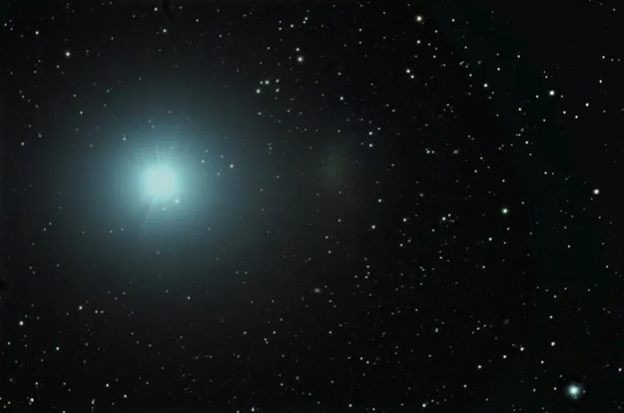by Rida Fatima

(Figure 1: The adjacent dwarf galaxy Leo I contains the second nearest SMBH. Credit: Scott Anttila Anttler.)
The nearest supermassive black hole (SMBH) to us is in the center of our Milky Way galaxy. The adjacent dwarf galaxy Leo I contains the second nearest SMBH. Roughly 820,000 light years, or about 30 times farther than the centre of the galaxy, separate Leo I from Earth. SMBHs are enormous objects, between 100,000 and ten billion times the mass of the Sun, but they are difficult to see. This year was the first that the one at the galactic core was imaged. In 2019, when Messier 87* was photographed, the first picture of an SMBH was captured. In 2021, the existence of the “Leo I*” supermassive black hole in the heart of Leo I was first hypothesized. Independent astronomers noted that as stars got closer to the dwarf galaxy’s centre, their orbits accelerated, which is a clear indication of a strong gravitational attraction. A SMBH is most likely to be the cause. (Pacucci et al., 2022).
The scientists calculated the acceleration of the stars as they are drawn into the SMBH’s gravitational field and estimated the black hole’s mass to be about three million times that of the Sun. Compared to the Sagittarius A* SMBH, which is four million times more massive than our Sun, this object is just somewhat smaller. It is now impossible to observe the black hole, which is a completely different thing than simply observing its gravitational effects.
A PROBABLE METHOD TO DETECT LEO I* IN FUTURE

(Fig 2: The ultra-faint Milky Way companion galaxy Leo I appears as a faint patch to the right of the bright star, Regulus. Credit: Scott Anttila Anttler.
The Astrophysical Journal Letters describes a novel approach developed by researchers at the Center for Astrophysics at the Harvard Smithsonian that tries to solve this issue. Lead researcher Dr. Fabio Pacucci claims that black holes are notoriously elusive objects and occasionally love playing hide-and-seek with us. The world surrounding them can be quite brilliant if enough material falls into their gravitational well, but light cannot escape from their event horizons. However, if a black hole is not accreting mass, it stops emitting light and is no longer visible to our telescopes (Pacucci et al., 2022).
Leo I* is difficult to see because of this. There is hardly any gas or other matter in its host dwarf galaxy, thus the black hole has nothing to accrete. It is said that the galaxy is a “fossil.” But according to the astronomers, there is still a chance of detecting the SMBH. According to Pacucci, “in our analysis, we proposed that a modest amount of mass lost from stars circling the black hole could give the accretion rate required to witness it.” “Old stars grow extremely large and crimson; we refer to them as red giant stars. Strong winds are generally present in red giants, which disperse a portion of their mass into the surrounding space. (Yazgin, 2022).
According to co-author Professor Avi Loeb, “observing Leo I* could be revolutionary.” With a very similar mass to the one at the heart of our galaxy, but being hosted by a galaxy that is a thousand times smaller than the Milky Way, it would be the second-closest supermassive black hole after that one. This discovery calls into question everything we’ve learned about how galaxies and the supermassive black holes at their centres co-evolve. How did a parent who was so thin wind up having a baby who was so big? The existence of a supermassive black hole at the heart of the majority of big galaxies has been thoroughly established in recent decades. However, the mass of the black hole is typically 0.1% of the combined mass of the stars that surround it. (Yazgin, 2022).
Loeb adds, “We would predict a significantly smaller black hole in the case of Leo I. Instead, Leo I seems to house a black hole similar to the Milky Way’s, with a mass a few million times that of the Sun. This is thrilling since unexpected events frequently result in the greatest achievements in science. We aren’t yet ready, according to the experts, to obtain a photograph of Leo I*. New data from the Very Large Array radio telescope in New Mexico and the Chandra X-ray Observatory space observatory are now being examined by the team.
Leo I* is probably playing hide and seek, but it produces too much radiation to go unnoticed for very long, according to Pacucci.
References
- Fabio Pacucci, Abraham Loeb. Accretion from Winds of Red Giant Branch Stars May Reveal the Supermassive Black Hole in Leo I. The Astrophysical Journal Letters, 2022; 940 (2): L33 DOI: 10.3847/2041-8213/ac9b21
- Yazgin, Evrim. “Hunt for Second Closest Supermassive Black Hole Begins.” Cosmos, Dec. 2022, cosmosmagazine.com/space/leo-supermassive-black-hole.
